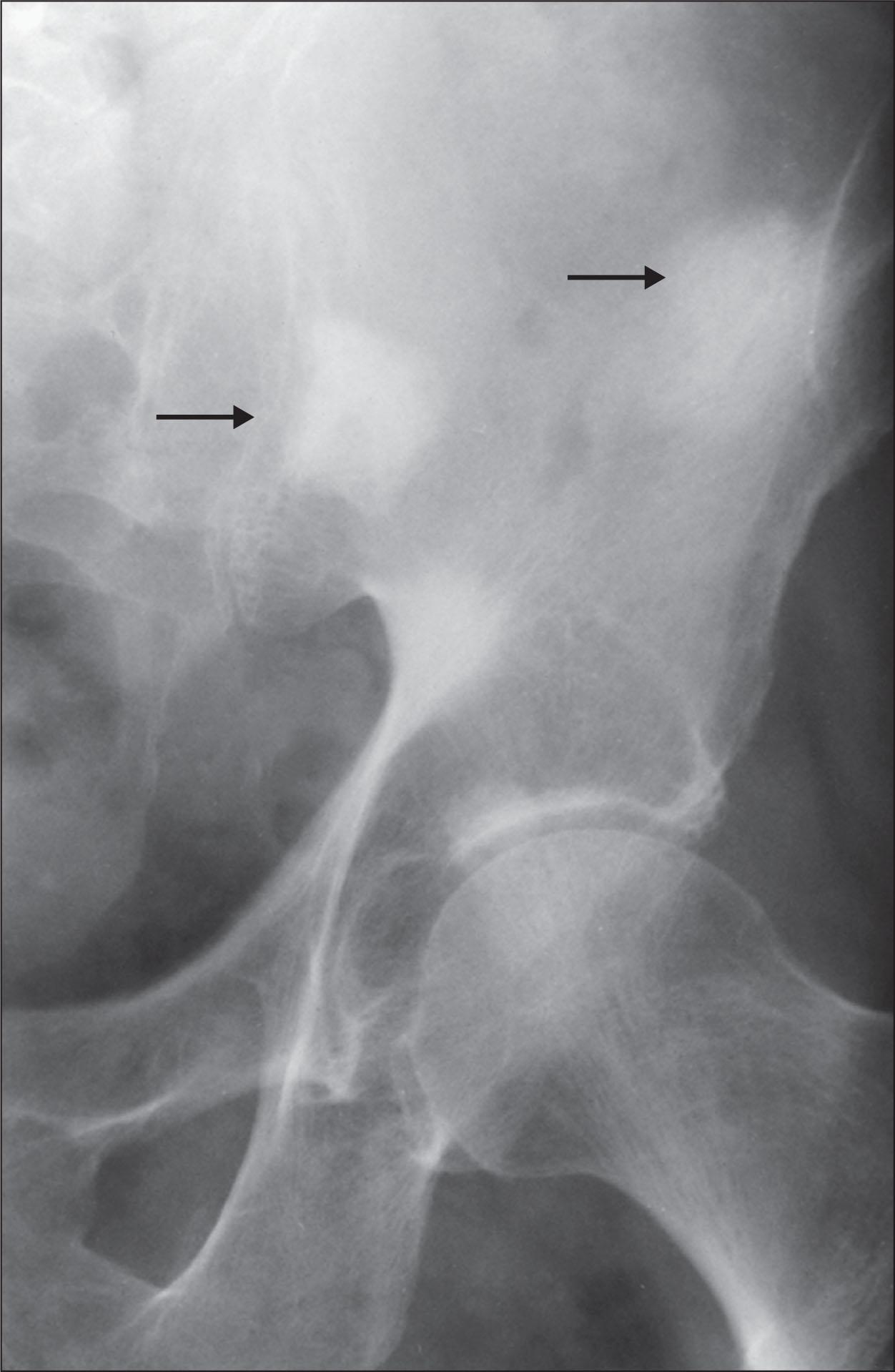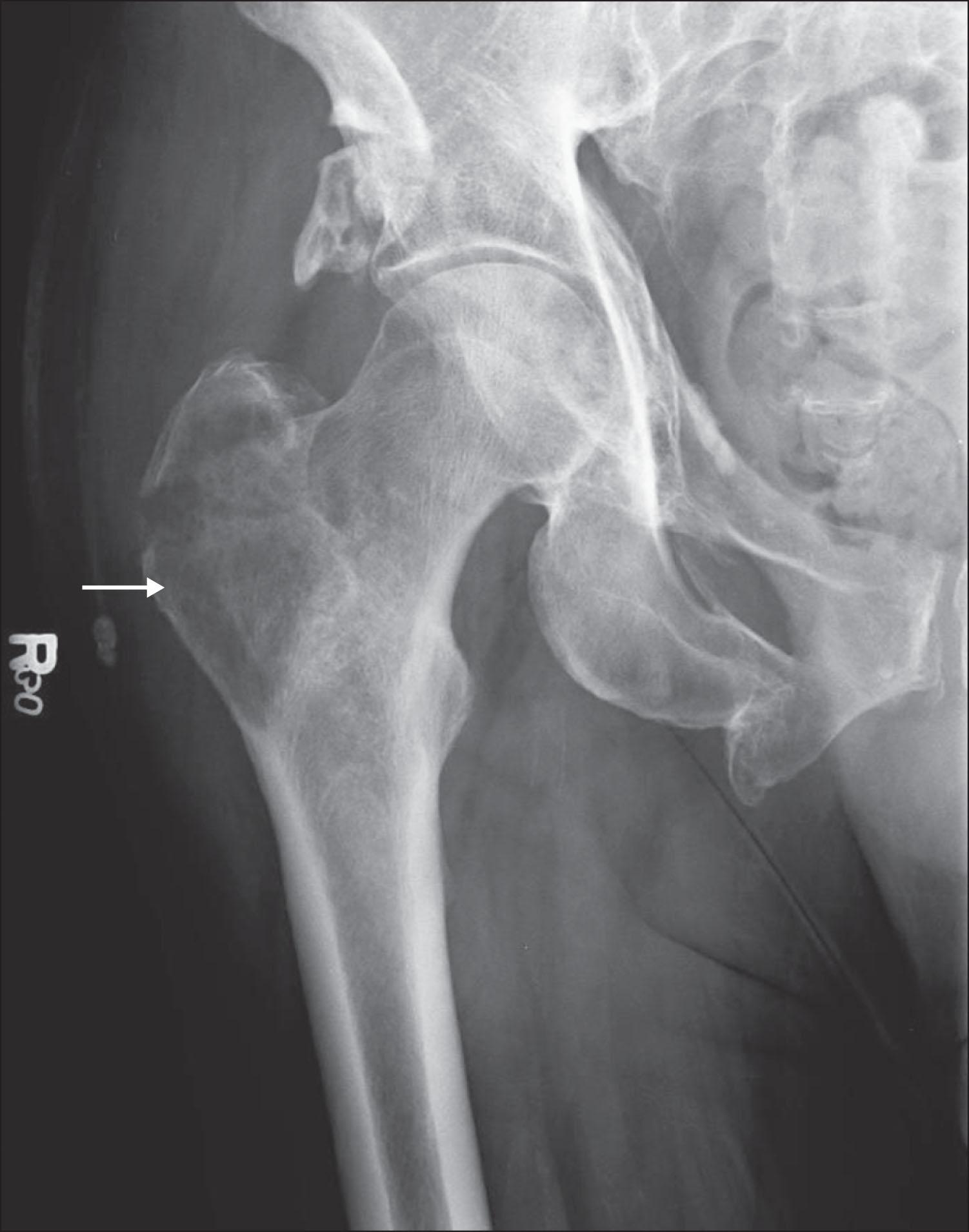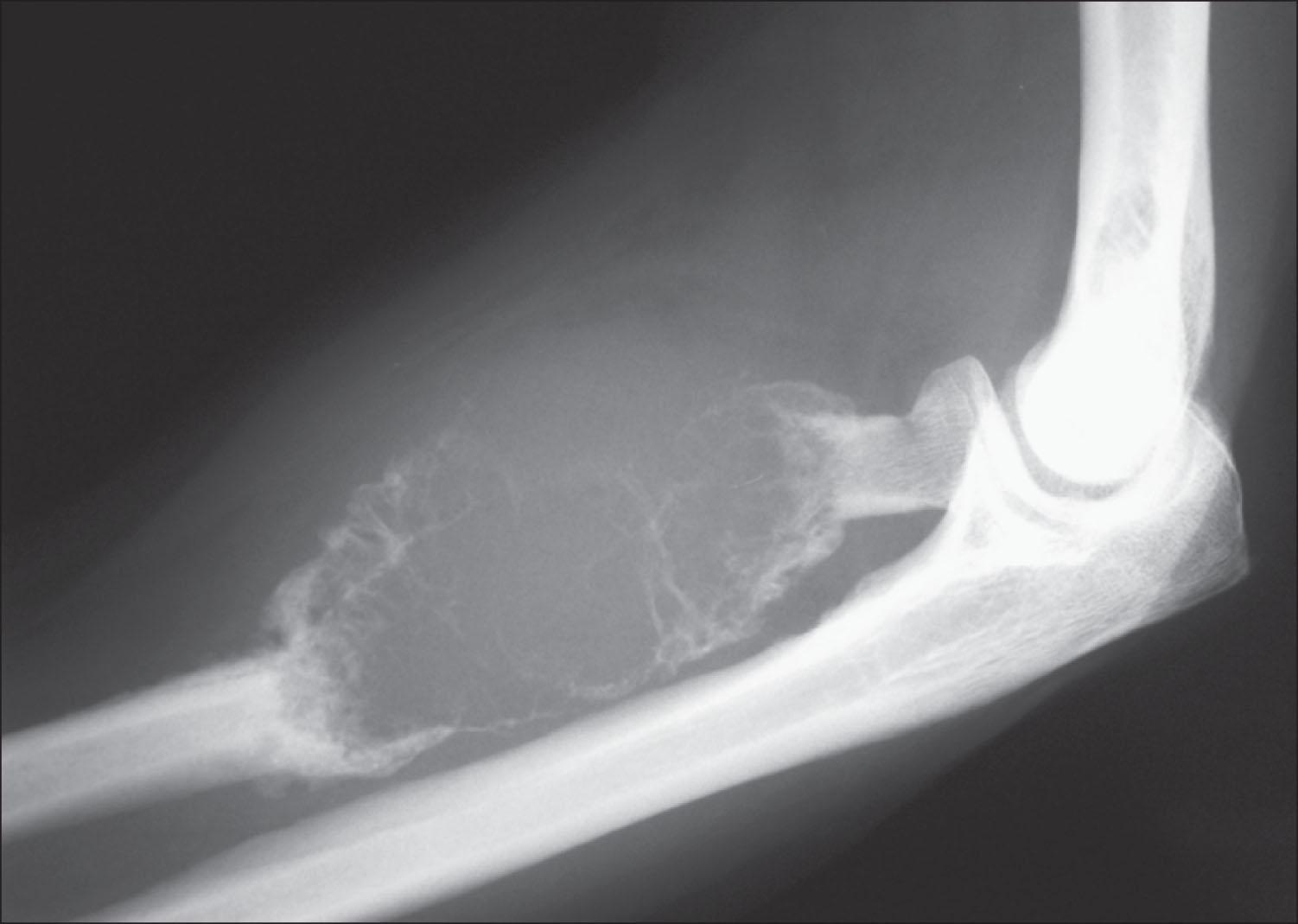Physical Address
304 North Cardinal St.
Dorchester Center, MA 02124
Bone tumors present with pain, swelling, pathologic fracture, or loss of use or as an incidental finding.
Urgent investigations of plain radiography, magnetic resonance imaging, or computed tomography are required with formal diagnostic core biopsy.
Older adults (older than 60 years of age) with a new symptomatic bone lesion should be considered to have either metastatic carcinoma or multiple myeloma until ruled out by diagnostic biopsy and myeloma and plasmacytoma screen.
Primary bone tumors are rare but have a bimodal distribution; the first peak is in adolescents and young adults, and the second peak is in older adults (older than 60 years of age).
There are more than 60 subtypes of primary bone tumors. Although most are benign, malignant tumors are often aggressive and require prompt treatment with curative intent.
Malignant primary bone sarcoma (low and high grade) should be diagnosed and treated in specialist tertiary centers by expert multidisciplinary teams.
The principles of modern metastatic and primary bone tumor management explicitly depend on the subtype and can include specific combinations of biologic therapy, chemotherapy, and radiotherapy, in addition to definitive en bloc (R0) surgical excision when possible.
The purpose of this chapter is to inform readers of the safe and correct approach to the diagnosis and treatment of bone tumors. Bone tumors frequently present with pain, signs of swelling and inflammation, and radiographic findings that can simulate infection and rheumatologic joint disease. Bone tumors may be divided into three general diagnostic categories: metastatic tumors to bone, hematologic malignancies involving bone, and primary bone tumors. A brief introduction to each of these three groups follows.
Malignant tumors typically present with pain, often around the knee and pelvis, that is nonmechanical in nature and worse at night, with the later sign of swelling when the tumor expands the bone cortex. The most common tumors in bone are those of metastatic carcinoma and myeloma typically presenting in middle-aged and older patients and reflect the incidence of solid cancers in these age groups. Non–small cell lung cancer, breast, prostate, colorectal, and unknown primary and upper gastrointestinal carcinomas commonly metastasize to bone and can first present with bone pain and often multiple bone lesions. Frequent sites include proximal limbs and axial skeleton. Rarer solid tumors, such as renal, bladder, thyroid, and soft tissue sarcoma, can also frequently develop bone metastases.
Metastatic lesions in bone may have a wide variety of radiographic appearances on plain x-rays, but most commonly there is either an area of subcortical or medullary lucency or cyst formation, often associated with reactive or new bone formation. If a bone tumor is suspected based on symptoms, clinical history, and examination, the current national and international guidelines should be adopted in the diagnosis and staging pathway. For staging of the lesion affected, regional or whole-body imaging is advised using either magnetic resonance imaging (MRI) or computed tomography (CT), respectively. The diagnosis should always be confirmed by either core biopsy or by collection of tissue at surgical stabilization before any definitive management plan involving surgical excision, radiotherapy, or oncologic therapy.
These also tend be more frequent in older adults, although lymphoma may present at any age. The two most common tissue diagnoses are multiple myeloma and malignant lymphoma of bone. Multiple myeloma and plasmacytoma, although not as common as metastatic carcinoma in bone, should always be considered when any older patient has either a solitary or multiple bone lesions. Multiple myeloma has a wide range of radiographic presentations, and in patients with suspicion of myeloma, serum (for monoclonal gammopathy) and urine (for immunoglobulin light chains) sampling should be taken before bone biopsy to rule out a myeloma diagnosis. Malignant lymphoma of bone is often a manifestation of an advanced stage high-grade lymphoma (IV), although rarely, malignant lymphomas may begin primarily in bone. With modern anti-CD20 and chemotherapy combinations, the overall prognosis for patients with bone lymphoma has greatly improved.
Primary bone tumors, the third category, are tumors that arise in bone and differentiate along skeletal lineages such as bone, cartilage, and fibrous phenotypes but also along unusual lineages. Primary bone tumors can be both benign and malignant. There are more than 60 subtypes based on the World Health Organization’s (2012) Classification of Tumours of Soft Tissue and Bone. Many primary bone tumors have diagnostic radiographic features. If they are benign, many need not be biopsied, and some may be followed by observation. On the contrary, primary malignant bone tumors require biopsy before appropriate treatment, and therefore any patient symptomatic with night pain should have a mandatory biopsy and expert pathologic opinion.
In contrast to metastatic carcinoma and myeloma, primary malignant bone neoplasms are rare (< 0.2% of all neoplasms), with a bimodal age distribution. The malignant high-grade tumors are more common in teenagers and young adults, in whom diagnosis is often delayed over months and even years, resulting in late presentation, frequent metastatic disease, and poor outcomes. The incidence of primary bone tumors is approximately 0.8 per 100,000 population, with the most common histotype being low-grade chondrosarcoma, often detected incidentally. For malignant high-grade primary bone tumors, osteosarcoma is the commonest at 1 to 1.5 per million population. Most bone tumors affect the sexes equally except for giant cell tumor of bone, which is more common in young women. Chondrosarcoma and some osteosarcomas, which are secondary to preexisting lesions such as Paget disease, infarct, or radiation, occur in the older age groups. The spectrum of primary bone tumors includes frequently detected benign cysts and lesions, such as benign nonossifying fibroma, estimated to occur in up to 30% of children but that spontaneously disappears in most cases.
Primary bone sarcomas need not be solitary, and multiple lesions are frequently detected in chondroma, osteochondroma, and more rarely multifocal angiosarcoma, osteosarcoma, and Ewing sarcoma (so-called “skip” lesions). The approach to primary bone tumors is therefore to first assess whether there are significant symptoms and then to perform radiologic assessment with plain x-rays and CT scans. Biopsy may not be indicated in asymptomatic and benign lesions, such as fibrous dysplasia, osteochondroma (and measurement of the associated cartilage cap by CT), simple bone cysts, enchondroma, and vertebral hemangioma.
Although the incidence of bone metastases in all patients dying of cancer is reported to be as high as 70%, it is probably even more common. The disease burden is therefore large and dominates the cancer clinical diagnostic services. Importantly, the advances in solid tumor treatment have increased cancer prevalence and survivorship overall. For noncancer clinicians, this means that cancer presents more often as a chronic disease, with a strong likelihood that this comorbidity will frequently coexist with rheumatologic and other conditions. Moreover, recent advances in immunologic therapies that modify T-cell checkpoints (anti-CTLA4, anti-PD1) frequently result in delayed autoimmune syndromes involving the intestine, liver, pituitary, skin, and musculoskeletal system. In some instances, bone metastasis can develop after many years of the disease course and represent an isolated site of relapse. Oligometastatic disease, either as late or early presentation, offers opportunity for radical surgical and oncology interventions, and associated outcomes can be extremely good. Thus it is not the case that all patients presenting with metastatic disease to the bone have a poor prognosis, so disease expert opinions should always be sought early in the diagnostic and treatment pathway.
In men, the most common metastatic tumors are from the lung and prostate. Even with screening with prostate specific antigen (PSA), almost one third of patients develop metastasis of prostate cancer during the course of higher grade disease. In patients with non–small lung carcinoma, bone marrow involvement can be detected in 5% to 21% of patients at the time of initial presentation and is more common in the rarer lung cancer small-cell histology.
Breast carcinoma is the most common type of metastatic tumor in women. As many as 21% of patients will have bone marrow metastases at the time of diagnosis, and the majority of the 45,000 women who die of breast cancer each year in the United States have bone metastases.
Metastatic carcinoma in bone is remarkable for its wide range of plain radiographic patterns. Lesions may be radiolytic or radiodense; they may be permeative or well defined; or they may be periosteal, intracortical, or intramedullary. As stated, the only distinctive feature of metastatic carcinoma in bone is its predilection for the axial skeleton, particularly the spine. Certain metastatic carcinomas, however, produce consistent radiographic patterns. For example, metastatic prostate cancer usually produces radiodense lesions, so-called osteoblastic metastases. Sometimes the osteoblastic metastases of prostatic carcinoma are widely distributed throughout the entire skeleton. Breast carcinoma can also be osteoblastic, but lesions are often mixed osteolytic and osteoblastic ( Fig. e218.1 ).
Metastatic lung carcinoma, by contrast, almost always produces radiolytic lesions ( Fig. e218.2 ). Lesions can be permeative or well defined, and there is often cortical destruction. Metastatic thyroid and renal carcinoma almost always produce lytic lesions.
Histologically, the characteristic feature of metastatic carcinoma in bone is an organoid growth pattern of neoplastic cells ( Fig. e218.3 ). The cells are grouped in tight clusters or lines, which are separated by a fibrous stroma. Often the clusters assume a glandular shape, a pattern suggestive of adenocarcinoma. Appropriate opinions from site-specific diagnostic pathologists should be obtained to help determine the primary site of the carcinoma using diagnostic molecular and immunopathology techniques.

Multiple myeloma is a malignant manifestation of plasma cell dyscrasia that results in bone lesions. Although plasma cells do not normally reside in the bone marrow, multiple myeloma is regarded by some as a primary bone tumor. Other malignant plasma cell dyscrasias include solitary myeloma of bone, osteosclerotic myeloma, and amyloidosis of bone.
Multiple myeloma accounts for approximately 1% of all malignancies in the United States each year with an annual incidence of about 13,000 cases. This disease is twice as common in African Americans and is more common in males than females (1.6 : 1.0 male : female ratio). It is second in incidence to only Hodgkin’s disease among the nonleukemic hematologic malignancies. Multiple myeloma is a disease of older adults and is generally discovered between the ages of 50 and 80 years. Therefore it should be considered in the differential diagnosis of all lytic bone lesions in patients in this age range. Fewer than 2% of cases occur in patients younger than the age of 40 years. The cause of myeloma is not known, although genetic, racial, occupational, and environmental factors have been implicated in some studies. Myeloma often has the most insidious and nonspecific presentation. Pain, present in two-thirds of patients, is the most common symptom. Back and chest pain (secondary to rib fractures) commonly occurs. Unlike the pain of metastatic bone disease, which is worse at rest and at night, the pain of multiple myeloma is precipitated by movement. In myeloma, the pain is often sudden in onset, and many patients remember the exact date and time it began.




The most common imaging changes are diffuse osteoporosis. The second most common radiographic changes of myeloma, however, are multiple discrete punched-out lytic bone lesions. They are most commonly seen in the skull, spine, pelvis, and proximal femurs or humeri. Lesions vary in size from 3 to 4 mm to 5 to 10 cm. They have well-defined borders and lack a sclerotic rim. In the long bones, a circular or elliptical lytic area may be seen on the endosteal bone surface. Larger lesions cause extensive cortical destruction ( Fig. e218.4 ). Histologically, myeloma shows sheets of atypical plasma cells, with genetic evidence of genetic driver balanced translocations in 40% of cases ( Fig. e218.5 ). Myeloma is associated with hypercalcemia and anemia and secondary renal failure caused by tubular nephropathy and Bence Jones proteinuria (monoclonal light chain casts).
Outcomes for patients with indolent and aggressive myeloma have much improved as a result of chemotherapy, targeted therapy with proteasome inhibitors, and the introduction of autologous bone marrow stem cell transplantation. Prompt referral to specialist myeloma or plasmacytoma specialist teams is therefore recommended to evaluate more advanced treatment options.
Malignant lymphomas are frequently caused by secondary involvement of bone marrow as a manifestation of disseminated disease. For example, bone marrow may be involved in disseminated small lymphocytic lymphomas and in many small-cleaved cell lymphomas. In these low-grade lymphomas, bone involvement does not necessarily carry a poor prognosis, and plain x-rays do not often show osseous abnormalities. In addition, secondary bone involvement may occur in patients with stage IV, high-grade lymphomas. However, bone involvement in these patients can indicate a poorer prognosis, although therapeutic anti-CD20 antibodies and peripheral blood stem cell transplantation and high-dose chemotherapy have markedly improved prognosis without inducing increased risk of secondary malignancy.
In contrast to secondary osseous involvement, a primary malignant lymphoma may rarely present in bone without evidence of nodal and visceral disease. Patients with primary malignant lymphoma of bone have a more favorable prognosis than those with secondary bone involvement. Primary malignant lymphomas of bone may occur at any age; patients range in age from 1.5 to 86 years, the mean being 46 years. Any bone may be involved, and 29% of patients have multiple osseous sites. The mandible, maxilla, femur, pelvis, and spine are the most common locations. Patients present with pain, often for a prolonged duration. Some patients with a lymphoma at the epiphyseal end of a bone can present with a joint effusion secondary to neoplastic involvement of joint structures.
Malignant lymphomas are characteristically diffusely permeative lytic lesions, which often involve a large segment of the affected bone and extension into the soft tissues. Lesions have varying amounts of intraosseous reactive bone, which imparts a mottled appearance ( Fig. e218.6 ). Malignant lymphomas of bone are usually diffuse, large-cell, noncleaved lymphomas. The neoplastic cells are usually uniform with a large round nucleus and clumped chromatin; cytoplasm is scant ( Fig. e218.7 ). However, some osseous lymphomas have cells with cleaved or even multilobed nuclei. Also, in rare cases, the cells may be pleomorphic and have abundant cytoplasm, a pattern consistent with immunoblastic lymphoma. Osseous lymphomas in children may be the lymphoblastic type and have small cells with round nuclei and fine chromatin.
Malignant lymphomas of bone are almost always B-cell neoplasms. Lymphoid origin is confirmed by a CD45 (leukocyte common antigen) stain. The B-cell lineage is confirmed by a CD20 stain. This latter stain differentiates the neoplastic cells from the inflammatory infiltrate, which usually consists of many T lymphocytes.
Become a Clinical Tree membership for Full access and enjoy Unlimited articles
If you are a member. Log in here